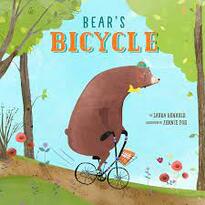 Guest review by Kristi Mahoney In Bear’s Bicycle, written by Laura Renauld and illustrated by Jennie Poh (Beaming Books, 2021) we are reunited with the lovable cast of characters first introduced by this author/illustrator combo in Porcupine’s Pie (Beaming Books, 2018). In this follow-up book, Bear wants to learn to ride his bike for the upcoming Summer Scoot. After multiple trips to the library to find a how-to guide, Bear discovers that doing everything by the book doesn’t always work out. Bear’s Bicycle is an endearing story about practice, perseverance, and the importance of friendship. Add in Jennie Poh’s whimsical illustrations and you have a book that will leave you feeling as warm and fuzzy as bear himself. On Writing:
Laura Renauld’s writing style is delightfully consistent with her original story in this series. It’s filled with things that I personally love in a book and appreciate as a writer: orderly lists, fun-to-say onomatopoeia, distinct voice, and bonus back matter that will delight anyone teetering on whether or not to take on a two-wheeler. And if you happen to fall in love with this woodland cast as fast as I did, you won’t have to wait long to see more of them. Cruise on over and pencil in the release date of the third book in this series, Squirrel’s Sweater (Beaming Books, anticipated September 21st, 2021). To learn more about Laura visit here.
0 Comments
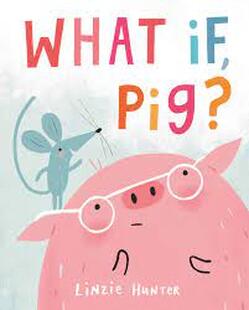 ~ Guest Review by Megan Litwin In What If, Pig? by Linzie Hunter (HarperCollins, 2021), we meet Pig and Mouse, and a supporting cast of colorful, cheerful animal characters. Pig is so kind and fun and generous that one day he decides to throw a party for all his friends. But Pig is also a worrier. A tremendous worrier. He worries that the party is a terrible mistake. A series of “what if” worries follow and spiral out of control. (Sound familiar, anyone?) Fortunately, Pig has good friends…friends who, as it turns out, sometimes worry too. The vibrant, colorful art and dynamic font that mimics Pig’s growing anxiety are perfect complements to the snappy text. What If, Pig? is a thoughtful book about friendship and kindness, worry and wonder. And a timely one too. As the world keeps changing and as perennial back-to-school worries crop up, this book offers a gentle springboard for discussion. On Writing:
Purposeful repetition can be a powerful tool in picture books, and Linzie Hunter does a fabulous job playing with repetition in her text. The use of “what if” as a sentence starter throughout the book, and also in the title, gives this a rhythmic hum, a predictable beat. But not too predictable. Hunter continually surprises the reader by changing the nature of the “what if” and the meaning behind it. “What if” thinking can be worrisome and negative, but it can also be wonderous, hopeful, and full of positive possibility. What if you read a book that warmed your own sometimes-worrisome heart so much that you told everyone about it? What if? You can learn more about Linzie Hunter here. 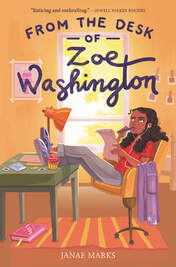 Review by Annie Cronin Romano FROM THE DESK OF ZOE WASHINGTON (Katherine Tegen Books, 2020) is a delightful mix of mystery and cupcakes! When Zoe, who dreams of becoming a famous baker, receives a letter from her incarcerated father on her 12th birthday, she finds herself determined to prove the innocence of this man she's never met. Her mother, however, wants Zoe to have nothing to do with her dad, so Zoe must sneak around in her efforts to correspond with her father and uncover the truth. A novel about the power of hope, forgiveness, and believing in others. On Writing Janae Marks takes a difficult subject (isolation from a parent) and makes it accessible to young readers in a gentle yet direct manner. Her handling of the father’s incarceration is presented thoughtfully, and the novel address faults and injustices in the legal system using an approach middle grade readers will understand. FROM THE DESK OF ZOE WASHINGTON is a solid mentor text for presenting social issues in an accessible, skillful way. The parallel plot of Zoe’s love of baking is seamlessly woven in with her pursuit to prove her father’s innocence, making this novel a prime example of how two strong parallel plots can work together to add dimension to the novel while simultaneously moving the main character’s story forward. To learn more about Janae Marks’ work, visit her website at www.janaemarks.com. 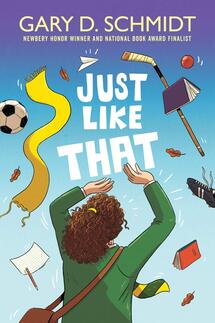 Review by Amanda Smith Gary Schmidt did it again! As in Ok For Now, Just Like That (HMH, 2021) takes place directly after The Wednesday Wars and follows a minor character from the Newbury Honor novel in their own coming of age story. Meryl Lee Kowalski, Holling Hoodhood’s best friend, is sent to a Maine boarding school after a devastating personal loss. Surrounded by shallow, spoiled girls, strict teachers blinded by tradition and decorum, and disturbing news from the war in Vietnam, Meryl Lee battles to keep the Blank at bay. But she also makes friends: Heidi with her hockey sticks; Mousy Marian (who learns to roar); and Bettey, a local girl employed by the school as serving staff. And Matt Coffin, the boy whose eyes tell Meryl Lee that he knows the Blank too. And then there is Dr. Nora MacKnockater, headmistress of St. Elene Preparatory Academy for Girls, who inspires Meryl Lee with her assembly speech on the first day of school. There will be Obstacles, Dr MacKnockater said, but the girls should have Resolve. And then they will grow Accomplished. Dr. MacKnockater who can focus her searchlight eyes on Meryl Lee as if she can spot the Blank when it attempts to overcome Meryl Lee. Dr. MacKnockater who takes Matt Coffin in from the streets and helps him face his own dark past when he cannot run from it anymore. Individually and together, under the protection and wisdom of Dr. MacKnockater, Meryl Lee and Matt resolve to overcome obstacles and challenge the status quo. The reader is swept along on their captivating journey to becoming increasingly Accomplished as they banish the Blank. ON WRITING: There is always so much to learn from a Gary Schmidt novel. One can get all wrapped up in his beautiful language use and unique turn of phrase. But more than anything else, Schmidt is a master at creating a rich and layered reading experience. In this novel, he adds layers through different devices: Just as in The Wednesday Wars and OK for Now, he uses classic literary works to emphasize character traits and showcase character development. For example, Meryl Lee draws parallels from The Wizard of Oz to her own life, while Matt dubs Dr. MacKnockater Bagheera after she reads The Jungle Book to him. As another layer, Schmidt solidifies setting by weaving paraphrased song lyrics from the sixties through the novel in a delightfully sweet and original way. Clever repetition, both in close proximity to emphasize emotion or heighten tension, as well as throughout the novel to bring deeper understanding, adds to the layers. He also uses capitalization of abstract concepts, such as resolve, to make them concrete and real, and give them presence. And he sprinkles in unexpected moments of laugh-out-loud humor to lighten the heaviness in both Meryl Lee and Matt’s stories. All of these layers lead to a tight narrative and a truly satisfying read. Learn more about Gary Schmidt and his books here. 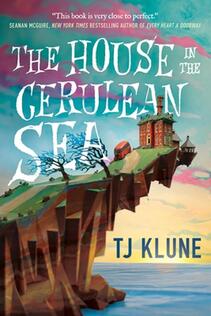 Review by Annie Cronin Romano THE HOUSE IN THE CERULEAN SEA (Tor Books, 2020) is a delightful story about 40 year old Linus Baker, a simple, straightforward fellow employed as a case worker for the Department in Charge of Magical Youth. Things go along rather routinely for Linus, until one day he is summoned to the Office of Extremely Upper Management and given a mysterious assignment: go to the orphanage on Marsyas Island and report back on the welfare of the six children there. With very little to go on, and with the knowledge that he will be given information only as it is warranted, Linus heads off. What he finds on the island challenges every notion he holds of the “magical” children he has previously encountered in his work. With each passing day, he finds it increasingly difficult to remain objective to the charms of the orphans—and their caretakers—all the while growing more suspicious of his employer’s true motives behind his visit. Part magical adventure, part social equality piece, part romance, THE HOUSE IN THE CERULEAN SEA is a charming, emotional, thoughtful novel that takes the reader on a journey to a beautiful island inhabited by unique, intriguing characters, all the while reminding us that not everything is as it seems—or, more importantly, as it should be. Read this story, and you’ll be dreaming of eating cherry ice cream with Linus and Arthur, gardening with Talia, listening to records with Lucy, and writing poetry with Sal! TJ Klune’s novel is an example of a beautifully written story laced with humor and infused with the themes of compassion and acceptance. ON WRITING So, why did I chose an adult book for my book pick when our blog’s focus is kidlit? Because sometimes the most valuable books to use as mentor texts are not always within your writing genre, and THE HOUSE IN THE CERULEAN SEA is one such example. And it’s interesting to note that this book does not fit neatly into any genre. Most libraries and bookstores have it in their adult fiction section. A few have chosen to place it on their Young Adult shelves. Others have it in Science Fiction. Regardless of where you find it, the story is the same: a delightful adult fiction story with a childlike whimsy. But more importantly for writers, this novel is a solid example of developing strong characters and allowing them to unfold and develop as the story moves along. In particular, the six magical orphans in this novel seem at first glance to be somewhat unlikeable and not fully in focus, but as the story progresses and the layers of each child are pulled back, what is revealed is truly magical and illustrates how characters must be given the space to grow and develop depth within a story’s arc. Rather than rushing to dump too much information at once, Klune patiently and expertly discloses his characters, allowing the reader to connect with them in a “real time” sort of way. THE HOUSE IN THE CERULEAN SEA is also a strong example of straddling the magical world and the realistic one in terms of setting and character-building. The reader is able to understand the underlying themes of social justice and kindness through this unique approach to world-building, all the while keeping the emotional aspect relatable, relevant, and appealing. To learn more about TJ Klune, visit his website at http://www.tjklunebooks.com. 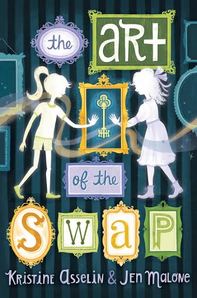 Review by Amanda Smith Hannah Jordan lives in a Gilded Age mansion. Well, actually, she lives in the converted servant’s quarters of a mansion. Her father is the caretaker of The Elms, one of the most esteemed historical properties in Newport, RI. Hannah is a history buff and loves all things antique, but mostly she adores the reproduction portrait of Maggie and longs to spend a day in the rich heiress’ shoes. Maggie is the twelve-year-old niece of the coal tycoon who built The Elms. Even though she loves her aunt and uncle, she finds her life mundane. Portrait sittings, tea with her stuck-up cousin, lawn tennis, and her aunt’s stifling opinions on what girls can and cannot do leave Maggie wanting. In FREAKY FRIDAY-like fashion, Hannah and Maggie swap places though a mirror in the mansion. Hannah, who revels in everything 1905, is set on solving the mystery surrounding the heist of the original Maggie portrait, with the help of kitchen boy, Jonah. Both girls believe solving the heist will switch them back. While Hannah plays investigator and has to swallow archaic beliefs about women, Maggie navigates modern technology, encounters vastly different family relationships, and experiences the liberties and opportunities brought about by the women’s rights movement. In this fun mystery adventure, the reader goes on a time traveling journey with Hannah, and experiences the wonders and restraints of the Gilded Age through the eyes of a modern twelve-year-old. The narrative leads the reader to reflect on today’s privileges and liberties that are often taken for granted. An endearing cast of characters strings readers along multiple twists and turns. They are forced to make difficult decisions and have us rooting for them all the way. Even though THE ART OF THE SWAP (Simon & Schuster/Aladdin; 2018) has two girl main characters, the adventure and mystery aspect, humorous situations, and a strong male character in Jonah make this a story boys and girls will enjoy. The story sheds light on women’s rights and gender inequality. It had both my sons thinking, noticing, and commenting. THE ART OF THE SWAP is an enjoyable book to read aloud with your kids and a perfect classroom book for 5th - 7th grade that will springboard interesting and important discussions. On writing: Hop on over to our blog here to read how Kris and Jen co-wrote THE ART OF THE SWAP. 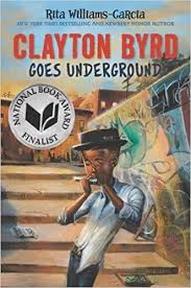 Review by Annie Cronin Romano In CLAYTON BYRD GOES UNDERGROUND, Clayton is devoted to two things: his grandfather and his blues harp (no, it’s not a harmonica!). All Clayton hopes for is a solo with the Bluesmen, the group his grandfather and Clayton perform with in Washington Square Park. So when Clayton’s grandfather, Cool Papa Byrd, dies unexpectedly, the soulful melancholy of the blues songs he played becomes all too real. Devastated by his mother’s insistence to rid their lives of all things that remind her of Cool Papa, Clayton takes off in search of the Bluesmen, certain that when he finds them, they’ll take him under their wing and mentor him musically as his grandfather did. And he’ll finally get that solo he’s wanted to play so badly. But life on the run has other plans for Clayton, and his harrowing adventure opens up problems Clayton never dreamed he'd encounter. Throughout the story, Rita Williams-Garcia tenderly and skillfully navigates the emotions Clayton experiences as he struggles with the sudden loss of his grandfather and the resentment he feels towards his mother, who wants to bury Clayton’s love of the blues right along with Cool Papa. CLAYTON BYRD GOES UNDERGROUND (Amistad, 2017) is a middle grade novel for children ages 8-12. This beautifully written story reads like a blues score with language that captures the very spirit of the music it features. On Writing Rita Williams-Garcia explores the complexity of losing a loved one from the child’s perspective while also depicting the contrasting experiences of the parent. Written in third person, CLAYTON BYRD GOES UNDERGROUND does not shy away from the difficult topic of death; it seamlessly weaves the sadness of loss with the joy of how a person’s impact can keep shining even after he's gone. The characterization is strong, and the wailing tones of a blues melody are captured in every line, making it a laudable example of using linguistic style to elicit the tone of a story. Rita Williams-Garcia is the bestselling author of many award-winning books, including One Crazy Summer and P.S. Be Eleven. For more information on her work, visit her website at https://rita-williamsgarcia.squarespace.com/. 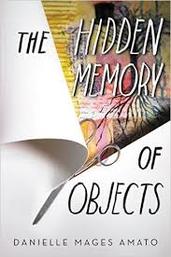 Review by Annie Cronin Romano In THE HIDDEN MEMORY OF OBJECTS, Danielle Mages Amato’s debut young adult novel, fifteen-year-old Megan Brown’s brother has just died, supposedly from a drug overdose. Megan is confused and angry, insisting the Tyler she knew never would have taken his own life, let alone used drugs. When the police start digging further into the circumstances surrounding Tyler’s death, Megan sees the memory of the brother she adored being defaced before her eyes. A talented collage artist, she turns to Tyler’s possessions to find comfort. In the process, she discovers she has an ability to “see” the memories held in those objects. It is a talent that causes Megan much upheaval and pain—literally—and takes her and two friends, Eric and Nathan, on a journey which generates more questions than answers about her brother’s life. Megan’s devotion to the brother she loved clashes abruptly with the betrayal she feels as she uncovers a side of her brother she never knew existed. In her attempt to makes sense of her newfound visions, Megan enlists the assistance of an artifact historian, Dr. Brightman, who specializes in "murderabilia"—and may have a few secrets of his own. As she seeks the truth about Tyler’s death, Megan learns there is far more to people than can be seen on the surface, even those she thought she knew the best. THE HIDDEN MEMORY OF OBJECTS, a contemporary young adult novel with a dose of paranormal, grabbed me from chapter one. Megan was a believable, likeable character, and her relationships with Eric, a close classmate, and Nathan, a friend of her brother’s whom she doesn’t recall meeting, add nice dimension to the plot. THE HIDDEN MEMORY OF OBJECTS blends family bonds, mystery, a touch of romance, betrayal, corruption, paranormal abilities, and history into an engaging, multifaceted journey. This beautifully written story kept me turning the pages long after I should have turned out the lights! On Writing Amato’s character development is strong, as she skillfully uses her characters' dialogue and actions to build their personalities for the reader. There is no info dumping here. She delves into the complex emotions that can arise with the tragic, unexpected loss of a loved one and portrays them in a believable manner throughout the story. Contemporary and paranormal genres are blended seamlessly, and every scene and character contribute to the movement of the tightly woven narrative. For more information on Danielle Mages Amato’s work, visit her website at www.daniellemagesamato.com. 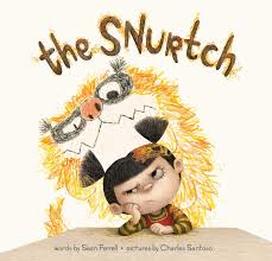 Review By Kelly Carey Whether you are 5 or 50, we all have a Snurtch that we must contend with and control. In Sean Ferrell’s THE SNURTCH, Ruthie is struggling to manage her Snurtch, a wonderful personification of her bad temper and poor behavior. Ruthie’s Snurtch causes big trouble at school...trouble for which Ruthie takes the blame. Ferrell’s book offers a platform for discussing those moments when we are not at our best. It is much easier to assess our own actions if we can blame our poor choices on a Snurtch, an ever present goblin of sorts that causes trouble. Ruthie’s Snurtch pulls her hair and makes her grumpy. He makes her run in the classroom and push her classmates. When she burps back at the Snurtch or returns his tongue out face, Ruthie ends up alone on the playground or relegated to the teacher’s time-out chair. Who can’t relate to being blamed for something you didn’t do? The Snurtch did it! But as Ruthie looks hard at the Snurtch, Ferrell finds a unique plot twist to show that Ruthie is ready to claim responsibility for the Snurtch. Ruthie transforms the Snurtch from a scapegoat for her misdeeds to a safe way to say “I’m sorry.” THE SNURTCH is a wonderful, whimsical, and humorous character, conjured up with the same care as the imaginary bunny Harvey who landed Jimmy Steward in a looney bin – lucky for Ruthie, she found a way not only to own her Snurtch, but she found classmates who have Snurtch issues of their own. On Writing Ferrell has taken a universal childhood problem – managing our behavior and impulses – and wrapped this complex problem up in simple straightforward text. His plot is complex, which keeps the pages turning and the story interesting – but the easy flowing text meets the readers at just the right level. What could be simpler and yet more provoking than an opening line that reads “Ruthie has a problem at school”? What I find most intriguing about this book is the wonderful marriage between the author’s words and the illustrations. While the book is illustrated with Ruthie and her classmates in fun and realistic artwork, the troublesome Snurtch is a crayon scribble that interacts with the other drawings like the cartoon Roger Rabbit walking amidst live action scenes and actors. The result is a clever visual representation of how the enigma of our mood and behavior can have a drastic effect on our everyday life. Read Ferrell’s wonderful picture book, and get a grip on your Snurtch. 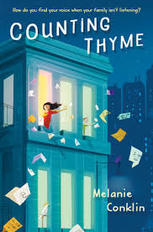 A review by Annie Cronin Romano In COUNTING THYME, Melanie Conklin’s middle grade debut, eleven-year-old Thyme Owens is uprooted from her San Diego home and moved to New York City so her younger brother, Val, can undergo experimental cancer treatment. Thyme is determined to return home by March so she and her best friend can celebrate their birthdays together. Challenges at her new school and having to share a room with her emotionally volatile older sister further spur on Thyme’s desire to return home. Thyme uses her parents’ time reward system—a half hour for doing the dishes, an hour for helping with laundry—to save up enough days to visit her best friend. With each passing day, however, Thyme is making friends and mediating drama in New York, and she feels herself drifting further away from her previous life. These changes heighten Thyme’s desperation to return home. Anger and fear set in as Thyme begins to suspect that returning to San Diego may not be part of her parents’ plan after all. Throughout the story, Conklin tenderly and skillfully navigates the conflicting emotions Thyme experiences as she struggles between the resentment she feels about moving and her fear of losing her brother to his devastating disease. COUNTING THYME is a contemporary middle grade novel for children ages 10 and up. This beautifully written story is engaging and heartfelt. A must read! On Writing With humor and sensitivity, Conklin delves into the complexity of dealing with what Thyme wants (to go home) versus what she has (a brother with cancer). Written in first person, COUNTING THYME does not shy away from the emotional struggles of having a family member battling a serious illness. Conklin illuminates the importance of selflessness and sacrifice without being preachy or heavy-handed. For more information on Melanie Conklin’s work, visit her website at www.melanieconklin.com. |
Our favorite mentor texts to guide your writing and revisions.
Categories
All
Archives
April 2024
|
 RSS Feed
RSS Feed